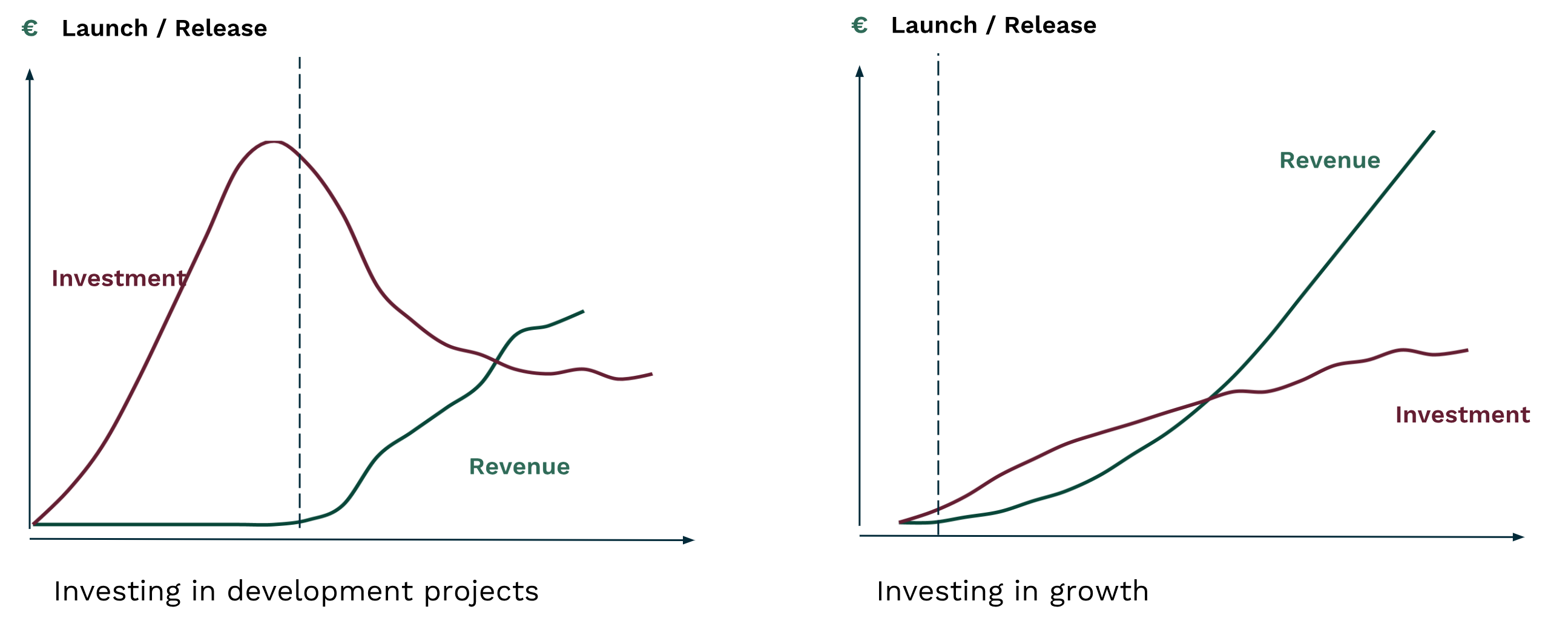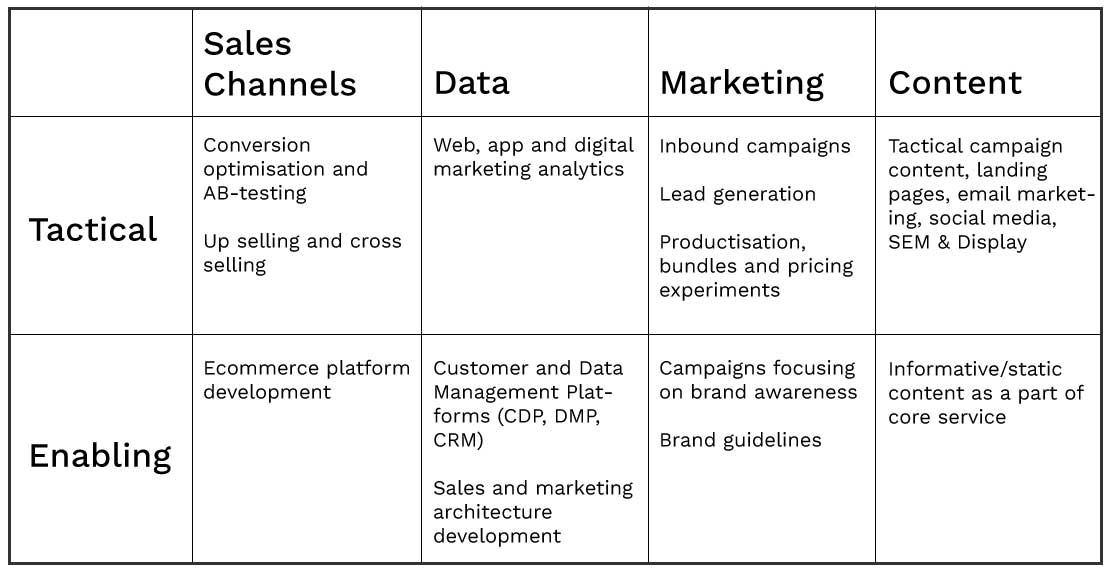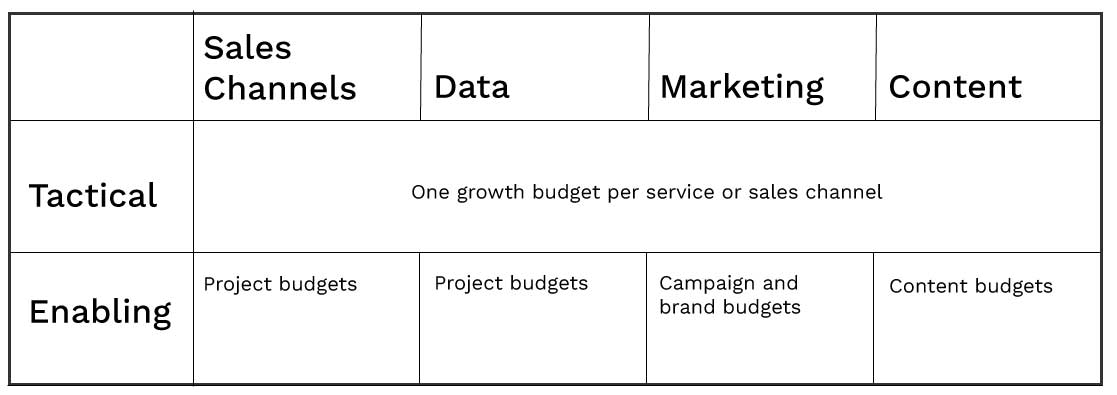The Data Handbook
How to use data to improve your customer journey and get better business outcomes in digital sales. Interviews, use cases, and deep-dives.
Get the bookThe human mind is simple. People tend to allocate money to tangible things like products or development projects with clear deliverables. However, before you release your sales channel, product or service, it produces zero revenue for your company and you can only guess what the potential ROI might be.
Investing in growth is the opposite. There is a lot of uncertainty of what the tangible outcome will be and, instead, you will constantly act towards impact on revenue and ROI.
Why is it so much easier to invest in building than growing?
The big picture: Tactical and enabling growth investments

Investing in traditional development projects vs. investing in growth
In many cases we have seen companies make large investments in renewing, for example, complete ecommerce ecosystems or marketing automation solutions due to legacy technology. Because that’s how you’re supposed to play the game today. However, these are investments in assets and capabilities rather than growth itself.
Many times these investments are indeed necessary, but presuming that a new online sales channel or marketing platform will automatically generate sales for you is an assumption you do not want to make. You need to invest in actual sales. The massive revenue potential of these kinds of investments that keep you waiting for results, for months or years, make you feel like you are investing in sales.
As a solution, we often advise our clients to map their digital sales resources and investments into tactical and enabling levels.
- Tactical level: Continuous growth activities, which typically aim at attracting more customers, converting them more efficiently, up & cross-selling to increase average purchase and avoiding churn. The scope would be a newly launched or current service or solution.
- Enabling level: Constructing building blocks that are enablers of revenue, but the investment in these does not directly impact sales or there is a major gap between investment and revenue accumulation.

Examples of growth investments on tactical and enabling levels
Very often, most of the resources (including internal and external people) are allocated into the enabling level, which do not generate direct revenue. Enablers are of course needed, but harvesting the revenue potential of those investments should be driven by actual growth teams, not by IT vendors, as is too often the mentality. Make sure to invest enough on tactical growth that brings in the revenue — often the optimal level of tactical investment is on par with the enabling investment.
Budgeting for tactical growth
The core of tactical growth level are cross-functional growth teams, whose KPIs are driven by sales revenue for their particular content — no matter if they are developers, copywriters or analysts. A well-tuned growth engine is also your best insurance for down-turn economy; sales and marketing cannot stop, but the engine must be efficient.
For growth teams to operate efficiently it’s critical that all their work come from one budget. This budget should be free from detailed plans and roadmaps. Where the budget is used should be decided on a weekly basis based on what activities at any given time are able to most positively affect the key metrics. The activities funded from this budget may be anything between software development, advertisements, marketing, content and customer care.

Budgeting on tactical and enabling levels of growth requires different approaches.
Budgeting tactical growth activities from various different tabs means challenges. As an example, all too often we have faced situations, where our client has set up a growth team, but the digital advertising budget has been handled by another unit and, therefore, the hands of the growth team are tied regarding customer acquisition and awareness.
Finally, tactical growth activities can be utilised to validate enabling investments. We, for example, have created manually written sales emails that looked like automated ones, in order to test whether personalised email marketing was something our client should invest in. After AB-testing the copy text with enough iterations, we reached a high enough email-to-purchase conversion rate to validate our hypothesis that investing in lightweight marketing automation would improve sales efficiency.
Keen on learning more on growth hacking? Learn how growth hacking can benefit your organisation and how you can incorporate it into your work and processes – Get your own copy of our popular Growth Hacker's Handbook below!
The Data Handbook
How to use data to improve your customer journey and get better business outcomes in digital sales. Interviews, use cases, and deep-dives.
Get the book




